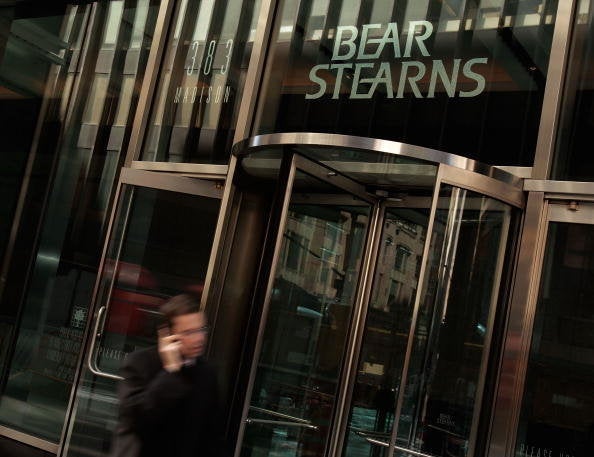
The former chiefs of failed investment bank Bear Stearns plan to tell an investigative panel Wednesday that the firm's demise was due to nothing more than "unfounded" and "irrational" "rumors" and "speculation" -- rather than the firm's over-reliance on short-term funding, its incredibly-high leverage ratio and overall failure to appropriately manage its risk.
In prepared remarks submitted to the Financial Crisis Inquiry Commission, James "Jimmy" Cayne, the former chairman and CEO of Bear, and his successor, Alan D. Schwartz, paint the firm as a victim of "overwhelming market forces" whose collapse could not have been averted.
In a September 2008 report, the Securities and Exchange Commission's Inspector General noted the SEC's lax supervision and "serious deficiencies" in oversight, Bear's "concentration of mortgage securities, high leverage, shortcomings of risk management... and lack of compliance" with international bank standards in its assessment of how and why the legendary investment bank failed.
Cayne's and Schwartz's planned remarks echo those of current and former top executives at virtually every firm atop the financial system, and the government officials who were supposed to be regulating them -- claiming that the financial crisis wasn't their fault but rather due to unprecedented and unforeseen quirks.
In March 2008, Bear was gifted to JPMorgan Chase, thanks to a nearly $30 billion federal bailout that placed virtually all the risk of Bear's toxic assets on the backs of taxpayers. JPMorgan Chase is thriving. Those assets now are owned by the Federal Reserve Bank of New York.
Further downplaying the firm's role in its own collapse, Cayne also plans to tell the FCIC that Bear Stearns "had limited involvement in the subprime sector," according to his prepared remarks. Schwartz will tell the bipartisan panel investigating the roots of the financial crisis that he "believe[s] that we did not foresee the extent to which housing prices had been driven to unsustainable levels."
A quick review of Bear's subprime activities, though, raises questions about Cayne's claims.
From 2004 to 2007, Bear Stearns issued more than $54 billion in subprime mortgage-backed securities, according to Inside Mortgage Finance, a leading trade publication whose data is used by the federal government. Bear also underwrote more than $97 billion in subprime mortgage-backed securities.
The firm was the third-highest issuer and fifth-highest underwriter of subprime mortgage securities in 2007 among Wall Street firms, according to Inside Mortgage Finance data. In 2006 it was third in issuance; in 2005 it was second.
Cayne, however, glosses over these statistics -- as well as the high-profile subprime-linked failure of two of the firm's hedge funds -- in describing why his firm went under.
"Over the course of 2007, the market for subprime and, increasingly, other mortgages continued to decline," he plans to say. "In view of Bear Stearns' leading role in the mortgage industry, these developments gave rise to market uncertainty about the firm.
"We believed that this concern was unjustified and that the firm had ample capital and liquidity."
Cayne also plans to say that concerns about the firm's solvency were "unfounded."
Counterparties and customers who fled the firm did so because of "rumors," according to Cayne. And the market's loss of confidence in the firm was "unjustified and irrational."
"Subsequent events show that Bear Stearns' collapse was not the result of any actions or decisions unique to Bear Stearns," he will say. "Instead, it was due to overwhelming market forces."
The firm was ultimately powerless, according to Cayne.
"Considering the severity and unprecedented nature of the turmoil in the market, I do not believe there were any reasonable steps we could have taken, short of selling the firm, to
prevent the collapse that ultimately occurred," Cayne will say according to his prepared remarks.
Meanwhile, Schwartz will say that Bear was "well-capitalized and had liquidity well in excess of
regulatory standards."
"At all times, Bear Stearns was compliant with the SEC's Consolidated Supervised Entities program's capital and liquidity requirements," Schwartz will add.
An internal SEC investigation raised serious questions about those standards and requirements.
Schwartz will go on to say that "unfounded rumors and attendant speculation" about the firm's liquidity pervaded the market.
"The rumors thus became a self-fulfilling prophecy: there was, simply put, a run on the bank," he'll say.
That's when the Fed decided to not let it fail, backstopping the firm's toxic assets and allowing JPMorgan Chase to scoop it up at a bargain.
Six months later the Fed and Treasury Department allowed Lehman Brothers, a Bear competitor, to fail.
The FCIC will begin hearing testimony at 9 a.m. ET on Wednesday.
